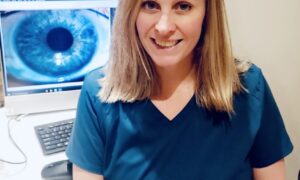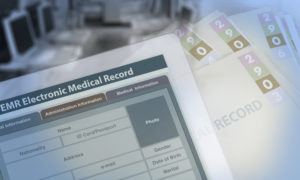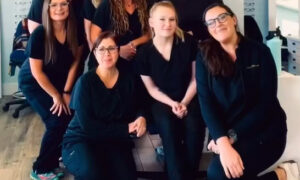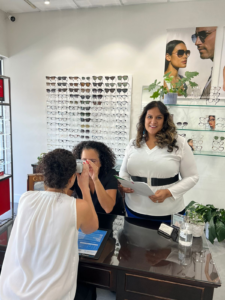
Dr. Jhagroo with an optician and patient in her office. She says that addressing binocular vision concerns has been a huge patient-pleaser and a significant profitability builder.
By Michelle Jhagroo, OD
June 28, 2023
Binocular vision dysfunction (BVD) is a common–and under diagnosed–visual condition. It can adversely affect quality of life, so it’s essential to screen all patients for this issue.
Here is how I make conscientious screening of BVD a part of my work as an OD and how it has significantly helped patients and substantially increased our profitability.
Symptoms Your Patients Might Not Connect to their Vision
Binocular vision dysfunction (BVD) is a condition commonly seen in clinical practice, and refers to a misalignment of the eyes causing a hindrance in their ability to fuse images. As the eyes struggle to fuse the images of each to create a single image, patients can experience many symptoms that they may not think are related to vision.
These misalignments can present in one eye, a tropia, or both, a phoria. If one eye is slightly aligned out, this is exotropia. If one eye is turned in, this is esotropia. Phorias can also be exo- or eso- depending on how the eyes present when testing together. As the eyes move together, saccades and pursuits, even minor misalignments, can trigger symptoms.
BVD can also be present when the eyes are focusing on things at different distances. As a patient looks into the distance, their eyes usually diverge or remain straight. When they shift to things that are closer, the eyes must converge to fuse what they are viewing. Too much (excess) or too little (insufficiency) convergence or divergence can also trigger the symptoms associated with BVD. Large differences of prescription between the eyes (usually more than 1 diopter) can also cause misalignments leading to these BVD symptoms and difficulties with stereo acuity.
Types of Patients Affected by BVD: Important Symptom Keywords
A wide range of patients experience symptoms associated with BVD. The patient cohort most aware of their symptoms early on are students, who have to shift focus when looking at a blackboard, computer screen or paper. Early awareness in this group enables us to catch and treat BVD sooner. As generations become more dependent on devices, even children as young as 4-5 years may describe symptoms of BVD.
In practice, many patients present at my office for their annual eye examination, and they may not report any obvious symptoms of misalignment until I ask them key questions. Bringing up keywords like burning, stinging, itching, or dryness of the eyes, headaches, dizziness, or neck pain, can help identify suspicion of BVD.
Some of these patients may have experienced symptoms for so long that they take them for granted. Others report consulting primary care or specialty physicians such as neurologists, who diagnose dyslexia, migraines, or even fibromyalgia, frequently a catch-all diagnosis. With everyone spending so much time on computers, phones, devices, etc., symptoms of BVD are becoming evermore prevalent.
Detecting & Treating BVDs
There are numerous approaches to binocular vision testing, including the basics: gross observations with testing extra ocular muscles, cover test (observing how the eye moves by covering and uncovering one and then both eyes), measuring stereo acuity, testing near-point convergence and accommodation and checking vergences and phorias. This is minimal testing that we do in practice every day on most, if not all, patients. If a patient is symptomatic when I perform binocular cover test, I often ask the patient to focus on an object and then I ask whether the image is moving. If they say yes, I can be certain that there is an element of BVD, and I will need to correct it.
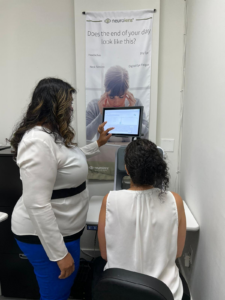
Dr. Jhagroo works with a patient getting measurements taken with Neurolenses’s measurement device, NMD2.
Many other tests are available, some simple and some automated. However, these tests do take time and not all offices are equipped with them. Newer devices with eye-tracking systems speed up the process quite a bit.
Many therapies exist to train the eyes, including traditional vision therapy, (VT) atropine therapy, patching and ocular exercises. These methods can be used when patients have more significant dysfunctions that are caught early. These can take months to years, and after a certain age, they may be less effective. Prisms are also used as the shift of images can trick the brain into fusing. A patient wearing contoured prism glasses is less symptomatic, whether driving or looking at a computer screen as this lens can handle focus at any distance, and no other type of prism can do that.
BVD Management Helps Patients AND Practice Profitability
Being able to offer vision therapy and the different treatment modalities available in my office is hugely important to helping patients and building profitability. Prescribing contoured prism lenses, such as those provided by Neurolens, is easier with modern devices that can measure to within a fraction of a diopter, and this sets us apart from other practices that rely on more traditional detection and therapy modalities. Contoured prism lenses are popular with patients, who often report greatly reduced symptoms and improved comfort.
Within one year of offering contoured prism lenses, we went from a gross income of about $850,000 to approximately $1.2 million, as patients discovered they’re suddenly not having the symptoms that bothered them all their lives. I had a patient come in and buy 10 pairs of contoured prism lenses just because he wanted all his glasses to have them.
Other Articles to Explore
Before we offered BVD solutions, we had just 1-2 BVD patients overall because that was not my area of expertise at the time. Using a questionnaire has made me realize how much BVD is undiagnosed or misdiagnosed. Now we have at least 1-2 patients a day who have heard about the glasses that resolved their friends’ symptoms, and they want to try them.
Offering a VT program requires not only the doctor and necessary equipment, but also a vision therapist dedicated to vision therapy. Some patients come in three times a week to do the exercises, which require special equipment which they do not have at home, such as the pegboards, specialized charts, balance board or walking rails, etc. Many people don’t realize that BVD is an issue until they see a doctor who is experienced in diagnosing and treating it, and they are able to experience greatly improved vision.
 Michelle Jhagroo, OD, practices at East Side Vision Center in Pompano Beach, Fla., and Weston Family Eyecare in Davie, Fla. She is also affiliated with The Florida Heiken Children’s Vision Program, a subsidiary of Miami Lighthouse for the Blind and Visually Impaired. To contact her: mjhagroo@gmail.com.
Michelle Jhagroo, OD, practices at East Side Vision Center in Pompano Beach, Fla., and Weston Family Eyecare in Davie, Fla. She is also affiliated with The Florida Heiken Children’s Vision Program, a subsidiary of Miami Lighthouse for the Blind and Visually Impaired. To contact her: mjhagroo@gmail.com.

